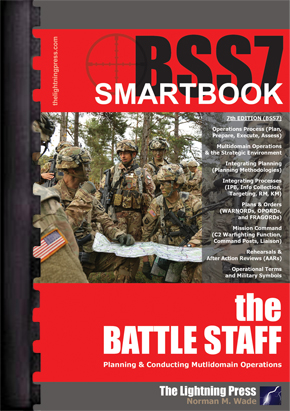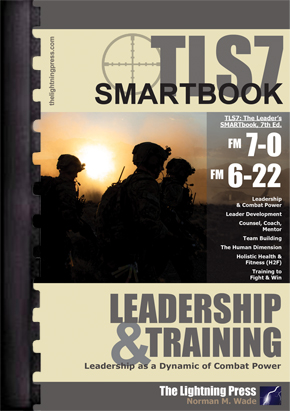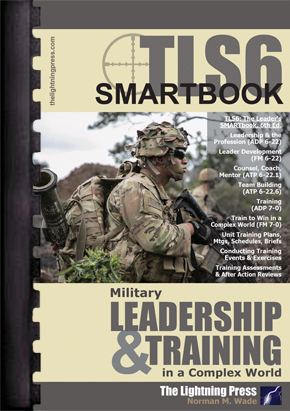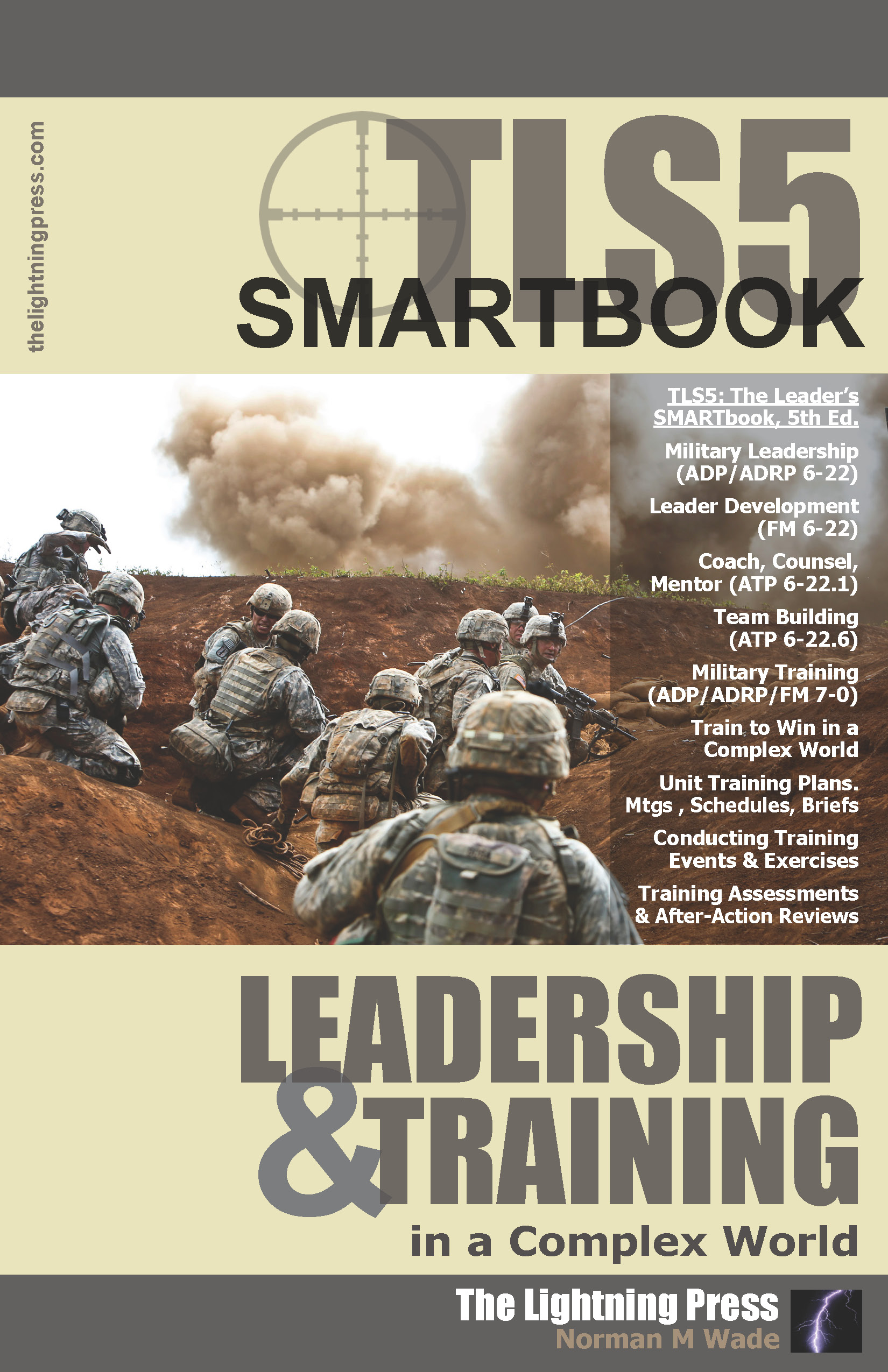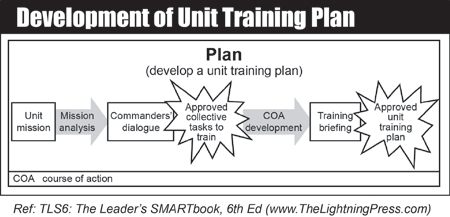BSS7: The Battle Staff SMARTbook, 7th Ed. is completely updated for 2023 to include FM 5-0 w/C1, Planning and Orders Production (2022); FM 6-0, Commander and Staff Organization and Operations (2022), FMs 1-02.1/.2, Military Terms & Symbols (2022); and more! Focusing on planning and conducting multidomain operations (FM 3-0 Operations, 2022), BSS7 covers the operations process; commander and staff activities; the five Army planning methodologies – Army Design Methodology (ADM), Military Decison-making Process (MDMP), Troop Leading Procedures (TLP), Rapid Decision-Making and Synchronization Process (RDSP), & Army Problem Solving; integrating processes (IPB, information collection, targeting, risk management, and knowledge management); plans and orders; mission command, C2 warfighting function tasks, command posts, liaison; rehearsals & after action reviews; and operational terms and military symbols.
Download a free PDF sample and learn more at: BSS7: The Battle Staff SMARTbook, 7th Ed. (Planning & Conducting Multidomain Operations)
Chap 1: The Operations Process (ADP 5-0)
The Army’s framework for organizing and putting command and control into action is the operations process—the major command and control activities performed during operations: planning, preparing, executing, and continuously assessing the operation. Commanders use the operations process to drive the conceptual and detailed planning necessary to understand their operational environment (OE); visualize and describe the operation’s end state and operational approach; make and articulate decisions; and >direct, lead, and assess operations.
Chap 2: Planning Methodologies (FM 5-0)
Planning requires the integration of both conceptual thinking and detailed analysis. Army leaders employ several methodologies for planning, determining the appropriate mix based on the scope and understanding of the problem, time available, and availability of a staff. Army planning methodologies include the Army design methodology (ADM), military decision-making process (MDMP), Troop leading procedures (TLP), rapid decision-making and synchronization process (RDSP),and Army problem solving.
Chap 3: Integrating Processes (ATPs 2-01.3/3-19/5-19/6-01.1)
Commanders and staffs integrate the warfighting functions and synchronize the force to adapt to changing circumstances throughout the operations process. They use several integrating processes to do this. An integrating process consists of a series of steps that incorporate multiple disciplines to achieve a specific end. For example, during planning, the military decision-making process (MDMP) integrates the commander and staff in a series of steps to produce a plan or order. Key integrating processes that occur throughout the operations process include intelligence preparation of the battlefield, information collection, targeting, risk management, and knowledge management.
Chap 4: Plans & Orders (FM 5-0)
A product of planning is a plan or order—a directive for future action. Commanders issue plans and orders to subordinates to communicate their understanding of the situation and their visualization of an operation. Plans and orders direct, coordinate, and synchronize subordinate actions and inform those outside the unit how to cooperate and provide support.
Chap 5: Mission Command (FM 6-0)
Mission command is the Army’s approach to command and control that empowers subordinate decision making and decentralized execution appropriate to the situation. Mission command supports the Army’s operational concept of unified land operations and its emphasis on seizing, retaining, and exploiting the initiative. The command and control warfighting function is the related tasks and a system that enable commanders to synchronize and converge all elements of combat power. The primary purpose of the command and control warfighting function is to assist commanders in integrating the other elements of combat power to achieve objectives and accomplish missions.
Chap 6: Rehearsals & After Action Reviews (FM 6-0 & 7-0)
Rehearsals allow leaders and their Soldiers to practice executing key aspects of the concept of operations. These actions help Soldiers orient themselves to their environment and other units before executing the operation. An after action review (AAR) is a guided analysis of an organization’s performance, conducted at appropriate times during and at the conclusion of a training event or operation with the objective of improving future performance. The AAR provides valuable feedback essential to correcting training deficiencies. Feedback must be direct, on-the-spot and standards-based.
Chap 7: Operational Terms & Military Symbols (FMs 1-02.1/.2)
Terms and symbols provide a common language used to communicate during the conduct of operations. FM 1-02.1 compiles all Army terms and definitions approved for use in Army doctrinal publications, including ADPs, FMs, and ATPs. Symbols are those graphics defined specifically for military use. They are codified in MIL-STD-2525D. Military symbols are logograms that represent words or terms used to depict abstract graphic representations of a unit, equipment, installation, activity, control measure, or tactical mission task relevant to military operations. These symbols are available for use in course of action sketches, visualizing operation orders, planning, maps, overlays, and command and control system displays to represent a current common operational picture.
Note: AODS7: The Army Operations & Doctrine SMARTbook (Multidomain Operations) is designed specifically to work hand-in-hand as a planner’s companion guide to BSS7: The Battle Staff SMARTbook, 7th Ed., with specific page references that lead to expanded content pertinent to understanding multidomain operations from FM 3-0. Save $14.90 when you order both together (bundle the print and digital versions together and save $74.80)! Read more here: ”Multidomain Operations” Planner’s SMARTset (2 books).
Browse additional military doctrine articles in our SMARTnews Blog & Resource Center.
About The Lightning Press SMARTbooks. Recognized as a “whole of government” doctrinal reference standard by military, national security and government professionals around the world, SMARTbooks comprise a comprehensive professional library. SMARTbooks can be used as quick reference guides during operations, as study guides at education and professional development courses, and as lesson plans and checklists in support of training. Browse our collection of Military Reference SMARTbooks to learn more.

